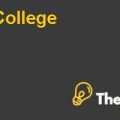IBM Network Technology (A) Case Solution
Target and Potential market:
The target and potential market for the chips of three different kinds i.e. networking processors, optical-to-electronic transport chips, and networking Sics. King was more concerned over leading the development of the relationship with giant makers of networking equipment, such as: Northern Telecom and new entrants like: Juniper Networks, in order to drive the innovative growth of the field.
Technological changes:
Although the organization represented no special technological approach to make conventional transport chips,but it had been operating as a leader in the utilization of optical technology,i.e. building of world-leading optical-to-electronic chips. Similarly, the technological approach to bring change in networking adopted by the Microelectronics Division involved new kinds of transport chips that could connect nodes to the optical fiber. The other involve a network processor chip with the capability of delivering the flexibility of software-driven-packet processing in combination with the processing speed of ASICs.
Value Proposition:
Considering the semiconductor technology;the majority of the work was known to be performed by ASIC. The key motive of this division was to leverage its superior designing and manufacturing abilities of semiconductors to the leader in the transport and network processing chips. This was done to allow the customers to conduct control processing with great flexibility. It mainly provided customers with an unlimited variety of packet-processing tasks. The technical staff and sales force of the division was known to be only associated with the customers of the division,to handle design work for individual customers.
Leadership of Chris King:
Chris King was considered as the right person to operate the business unit as each leader has his own style of leadership. As a former leader, she represented considerable experience in working with the professionals of product development. Although the development engineers were known to be uncomfortable with her commitment and create awareness among the customers about the tendency and the speed of the organization to meet the forecaster demand of the customers. Despite the devotion of her considerable energy to persuade people;she was able to lead the product development and provide the product that was needed by the customers.
For the sale of semiconductors outside the organization, she led the hiring of experienced semi-conductor salespersons from other companies who significantly enjoyed the excitement of a high-growth business. In contradiction to the leadership of Tom Reeves who ensured the reliable production and delivery of semiconductors to the customers stated that setting unrealistic goals like King might question might result in emotional exchanges only.
Kelly support to new BU against skeptics:
According to Kelly, King had the right personality to create powerful business i.e. Horizon 2 and Horizon 3 to provide services to the markers of networking equipment. Although the previous job responsibilities of King did not involve monitoring of profit and lost her personality, drive, and the capability to influence others to give a try to new things were the key characteristics that were needed to be taken under consideration. Kelly had spent several hours with King and the top technical people of the division to discuss the business plan and its demands in terms of investment.
However, the strategic approaches of Chris were considered to be out-of-control by almost half of the organization i.e. making commitments that were not easy to be kept and work with the customers in a completely different way in comparison to the organization’s traditional approach But, the approach of King was considered to be highly effective, which could allow the organization to be the next Cisco,because many of the people were known to face difficulty in designing parts as a startup,but Chris had the ability to execute the plan effectively.
Change in organizational culture:
Initially, the culture of the organization was found to be associated with careful manufacturing and superb engineering. This was considered to be true for the Microelectronics Divison, which dealt in the production of superior computer chips. But, the culture of the Network Technology business unit differed based on the need of building a business from no resources or assets to billion dollars in about one to two years. Similarly, the behavioral approach of the King and her team members also differed with both the engineers and the marketing people. As it was a bit easier to bring sales staff from different divisions together because of their interest in the process.
There was a requirement to find the new managers for three business units outside the business unit of Network Technology. The selection approach for managers adopted by King was primarily based on the attitude of the candidate rather than being more focused on the resume. She hired Jim Northington based on his statement during the interview “dying to beat the competition” to run the business of Network Processor. For the transport business, she hired Dale Chris who had worked for Tom Reeves on the early electronic-to-optical devices in the Storage division. For the Custom Logic Business, she selected David Belkin who had offered his services in the field engineering organization and continued to do so, even after the launch of Network Technologies. The reason behind the selection of David was his ability to address the complex operational issues. Similarly, Victor Lee was made the head of the Business Development for tracking the customers’ needs and making sure that the business unit as a whole had been positioned in the state of fulfilling the customers’ needs.
Separation of Business Development Unit:
The approach of making a separate business development unit was mainly based on the notion that it would assist in holding the business operations together. Initially, the sales of the business unit were booming and the managers of the Network Technology enjoyed the wonderful period of early 2000. Based on the functioning of the three business units as a team, there was a requirement to deliver a comprehensive solution to the customers. With the increased demand for the chips, the manufacturing capacity of the business unit had strained despite of aggressive investments. Due to this reason, the ability of the business unit to meet the customers’ demands had been impossible. Although the business unit had been able to understand and identify how much capacity was left, still the manufacturing could not be sustained in the long-run. Thus, the decision of separating the business development unit was not appropriate at the initial stage. However, it had to be separated after the team had developed the skills and abilities required to meet the customers’ demands...................
This is just a sample partial case solution. Please place the order on the website to order your own originally done case solution.











